 “Turkey ready pool love” Joey said as we read Red Hat, Blue Hat by Sandra Boynton. Sure enough, on the next page, the turkey was getting fully dressed to jump into the pool. Joey giggled and held a small stuffed turkey in the air. “Up!” he said, grinning. “Up”.
“Turkey ready pool love” Joey said as we read Red Hat, Blue Hat by Sandra Boynton. Sure enough, on the next page, the turkey was getting fully dressed to jump into the pool. Joey giggled and held a small stuffed turkey in the air. “Up!” he said, grinning. “Up”.
As Joey’s use of his AAC eye gaze device has increased I have begun including the communication purposes of Joey’s utterances into my data collection. While at first we were just tracking how often Joey used the device within a ten minute period, this summer we realized that it was time to expand our observations. Now, when we take a language sample for ten minutes we track the observable purpose of Joey’s communication.
After reviewing Joey’s previous data samples, we broke his communication purposes into seven categories. Demands, Social Exchanges, Responding, Exploring Words, Observations, Feelings, Mishits. Definitions and examples of each of these categories are listed below.
The data reveals that in August, Joey communicated primarily to share his observations of the world with his communication partner (31.5% of the time). Responding to questions is 18.2% of his communication, social exchanges includes 13.9%, making demands is 8.5%, and expressing his feelings is 2.4% of his communication purposes. As interpreted by the data collector, it appears that Joey hits a word he did not intend to hit 4.8% of the time.
What does this tell us? Joey enjoys sharing his observations with his communication partner, and seeks to share what he sees and hears with others. He does not just view those around him as a way to have his needs met, but instead looks to connect with others through telling them about his world. He also enjoys exploring words on his device. The “exploring word” category is often difficult to interpret because one has to determine if Joey is giving a set message, or if he is simply finding his favorite words. Is he saying “goose” because he wants to read a book about a goose, or is it just a fun word to say?
Joey also communicates frequently to respond to his communication partner, while his use of communication to fulfill a need is limited. He makes demands when he drops a toy or wants a family member or certain book, but he has fewer reasons to make demands on his environment than he does to interact with it through sharing observations, or answering questions. Joey labels his feelings the least, which surprised me because I feel like he is often telling me “mad” “frustrated” or “bored.” Maybe those moments just stay in my head more than others.
I continue to want to increase Joey’s social communication so that he moves beyond sharing observations and toward more natural interactions with his communication partner.
Types of Communication:
Observations: This is when Joey tells us he hears an airplane, that his mom is gone, that something is loud, or what is happening in a book. He may say “bad gorilla” if there is a picture of a gorilla making a mess, or “duck on bike” to describe the picture. Sometimes Joey will verbally say “UP!” and hold up an animal. Because he is labeling his movement as he does this, his “up” is counted under this category.
Exploring Words: This is when Joey appears to be exploring his device to say words, or simply clicking on his favorite words. This category is often hard to determine, because these appear to be random, but may be included inside a message that I missed, or Joey may have selected the word by accident but it was not a recognizable mishit.
Responding to Questions: This is when Joey responds to a direct question like “How does the character feel?” or “What does the hen see?” or “How many crayons are there?”
Social Exchanges: These include when Joey says common social greetings like hello, goodbye, “how old are you?” and “I am four years old.” It also includes when Joey makes verbal utterances with the purpose of connecting with those around him. Sometimes he will say “oh” or “go go go” which appear to be his attempts at orally interacting with his partner. If he is looking toward the partner and hoping to engage, these utterances are counted here, under social exchanges.
Demands: This category includes when Joey wants something he’s dropped on the floor, wants a family member to come in from another room, or when he wants to play with glasses, eat a cookie, etc.
Mishits: At times Joey has difficulty holding his eye gaze long enough to select the correct word. At these times, Joey’s errors are included in his total word count, but are noted to be mishits. Often Joey will try again to select the correct word. However, at times I suspect Joey has not selected the correct word and that it is not obvious to those around him. This category may be larger than reported here, and the “exploring words” category may be smaller.
Feelings: This includes when Joey shares how he is feeling about an activity, whether he is frustrated, mad, bored, or happy. At times Joey also shares that he loves something, which is also included here.


